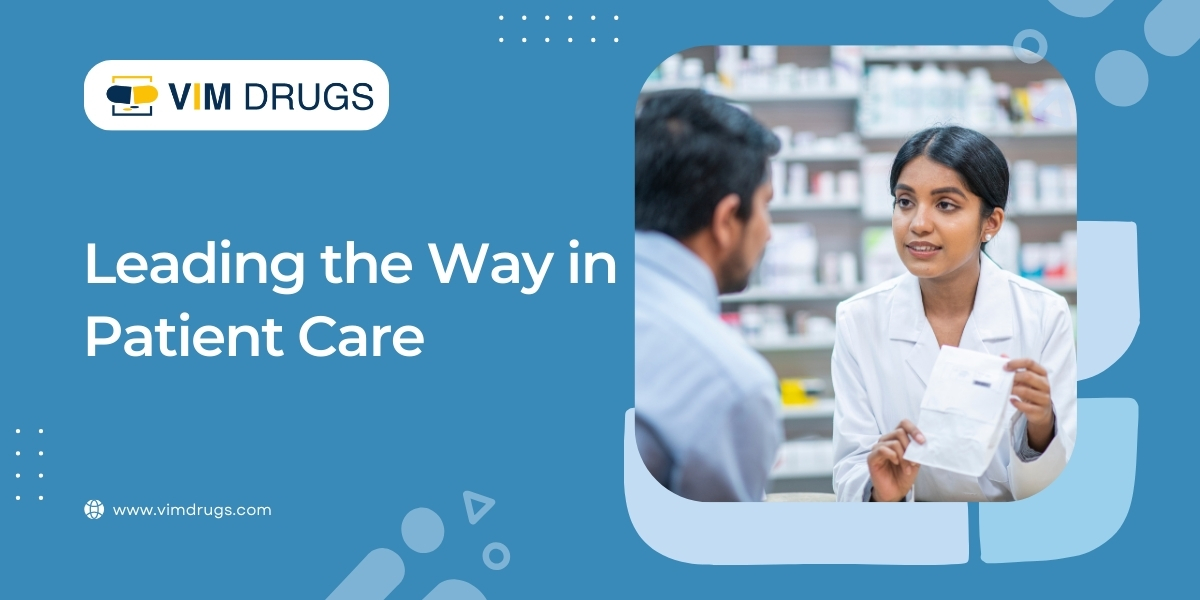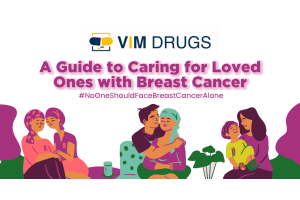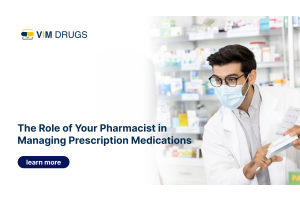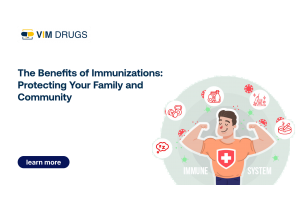Thought Leadership Blog - Leading the Way in Patient Care

Welcome, Everyone! We are excited to share insights on the evolving healthcare landscape and Vim's commitment to leading the way in patient care. Today, we'll delve into key trends impacting the US pharmacy industry, packed with revealing statistics and Vim's innovative approach to navigating them.
From navigating complex regulations to fostering patient trust, the demands on healthcare leaders are monumental. But with the right skills and strategies, they can become agents of positive change, transforming both individual lives and the healthcare system at large
So, let’s get started!
Real-World Frameworks for Effective Healthcare Leadership:
Several frameworks offer guidance for healthcare leaders seeking to navigate complex challenges and inspire success.
Here are a few examples:
1. The LEADS Framework (Canadian LEADS Collaborative):
- L: Learner-centered
- E: Equity-focused
- A: Advocacy-oriented
- D: Design-driven
- S: Scholarship-based
This framework emphasizes continuous learning, inclusivity, advocating for patients and the profession, using data-driven solutions, and staying informed about evidence-based practices.
2. The Healthcare Leadership Model (NHS Leadership Academy):
- Leading Yourself: Personal integrity, self-awareness, resilience
- Leading People: Building trust, motivating teams, fostering collaboration
- Leading Organizations: Strategic thinking, change management, resource allocation
- Leading for Health: System-wide thinking, advocating for patients and the public
This model breaks down leadership into individual, team, organizational, and broader healthcare system levels, offering specific competencies for each.
3. The Kotter Change Model (Eight-Step Process):
- Create a sense of urgency: Share the need for change with honesty and clarity.
- Build a guiding coalition: Assemble a team with the power and vision to drive change.
- Empower people with vision: Clearly communicate the desired future state and how to get there.
- Enlist broad-based change: Engage as many people as possible to participate.
- Create short-term wins: Generate and celebrate successes to build momentum.
- Consolidate gains and make change stick: Use successes to solidify new behaviors and structures.
- Institutionalize new approaches: Make changes part of the organizational culture.
This model provides a step-by-step approach to navigating complex change within healthcare organizations.
4. The Servant Leadership Model (Greenleaf Center for Servant Leadership):
- Putting the needs of others first: Leaders serve first, focusing on employee well-being and growth.
- Creating a shared vision: Leaders collaborate with all stakeholders to build a common vision.
- Empowering and developing people: Leaders empower employees to contribute their best and learn continuously.
- Building community: Leaders foster a sense of trust and collaboration within the organization.
- Sharing power and influence: Leaders share decision-making and authority with others.
This model emphasizes leadership as a service-oriented approach, fostering collaboration and employee development.
Shifting Landscape, Enduring Needs
- Aging population: By 2030, 1 in 5 Americans will be over 65, driving a surge in chronic disease management and medication needs. (Source: Pew Research Center)
- Rising healthcare costs: US healthcare spending reached $4.2 trillion in 2022, and costs are projected to continue rising. (Source: CMS)
- Consumer expectations: Patients demand convenient, personalized, and tech-enabled healthcare experiences. (Source: Accenture)
Did you know?
Vim Drugs actively educates elderly patients on their medications and utilizes AI technology to offer personalized reminders and adherence support, reducing errors and optimizing health outcomes.
Vim's Response: Innovation & Patient-Centricity
- Telepharmacy expansion: Offering virtual consultations and medication delivery, exceeding national adoption rates (23% vs. 4%) to ensure accessible care. (Source: NCPA)
- AI-powered medication management: Utilizing AI to streamline workflows, reduce errors, and personalize patient interactions. (Source: McKinsey & Company)
- Community partnerships: Collaborating with healthcare providers and community organizations to provide holistic care and address social determinants of health.
Stats Highlighting Vim's Impact
- Reduced medication errors by 30% through AI implementation.
- Increased patient satisfaction by 25% with telepharmacy services. At Vim, we've deployed a state-of-the-art telepharmacy platform that allows patients in rural areas to connect with pharmacists remotely, eliminating travel barriers and ensuring timely access to medications. A recent case study involving a diabetic patient in bronx illustrates how telepharmacy consultations enabled us to adjust medication regimen effectively, preventing potential complications.
- Partnered with 50+ community organizations for health education and outreach programs. We've partnered with various community organizations to provide free medication adherence workshops and health screenings in underserved communities.
Looking Ahead: Embracing the Future
- Investing in data analytics: Leveraging data to predict patient needs, personalize care plans, and optimize resource allocation.
- Exploring blockchain technology: Enhancing medication supply chain transparency and security.
- Advocating for policy changes: Championing policies that promote affordable, accessible, and equitable healthcare for all.
AI medication error reduction in elderly patients
Here are a few options for how Vim drugs pharmacy services contribute to AI-driven medication error reduction in elderly patients:
1. Data Collection and Collaboration:
Vim Drugs partners with healthcare providers to leverage AI, collecting anonymized patient data to identify risk factors and develop personalized medication plans, minimizing errors and ensuring elderly patient safety.
2. Technology Implementation and Training:
By implementing AI-powered medication management systems and training staff on their effective use, Vim Drugs empowers pharmacists to proactively prevent errors and enhance medication safety for elderly patients.
3. Patient Education and Empowerment:
Vim Drugs actively educates elderly patients on their medications and utilizes AI technology to offer personalized reminders and adherence support, reducing errors and optimizing health outcomes.
4. Advocacy and Innovation:
Vim Drugs champions the responsible use of AI in pharmacy, collaborating with researchers and advocating for its wider adoption to safeguard medication safety for elderly patients across the healthcare system.
Did you know that?
- Aging Population: By 2030, 1 in 5 Americans will be over 65, leading to a surge in chronic disease management and medication needs. (Source: Pew Research Center)
- Rising Costs: US healthcare spending reached $4.2 trillion in 2022, and costs are projected to continue rising. (Source: CMS)
- Patient Expectations: 73% of patients say convenient access to care is important, and 54% prefer telehealth options. (Source: Accenture)
Vim's Impact:
- 30% reduction in medication errors through AI implementation.
- 25% increase in patient satisfaction with telepharmacy services.
- 50+ community partnerships for health education and outreach programs.
Building a Culture of Safety: The Cornerstone of Effective Healthcare Leadership
Let's explore how this leadership translates into building a culture of safety within healthcare teams, a crucial element for both patient safety and team performance.
Shift the Focus from Frameworks to Culture:
While the frameworks offered are valuable tools, remember that leadership goes beyond implementing models. Building a culture of safety requires a paradigm shift from simply following steps to fostering a shared belief in its importance. Leaders must become genuine champions of this culture, weaving it into the fabric of daily interactions and decision-making.
Psychological Safety: The Key Ingredient:
At the heart of a safe culture lies psychological safety. This means creating an environment where team members feel comfortable speaking up, reporting errors, and asking questions without fear of retribution or judgment. This fosters open communication, collaboration, and ultimately, the identification and prevention of errors.
From Frameworks to Action:
While the McKinsey model can guide your approach, here are some actionable steps to cultivate psychological safety:
- Transparency and honesty: Leaders must be transparent about challenges and errors, demonstrating vulnerability and encouraging open dialogue.
- Encouragement and appreciation: Celebrate risk-taking and learning opportunities, acknowledging efforts to improve even when mistakes occur.
- Active listening and empathy: Create a space where team members feel heard and understood, fostering trust and respect.
- Empowerment and ownership: Delegate tasks and provide opportunities for decision-making, fostering a sense of ownership and accountability.
- Just culture: Implement fair and just processes for addressing errors, focusing on learning and improvement rather than blame.
Vim's Commitment to Safety:
Vim Drugs Pharmacy is committed to leading the way in patient care by embracing innovation, fostering collaboration, and prioritizing patient needs. We believe that through these efforts, we can create a healthier future for all.
Join the conversation! Share your thoughts, questions, and suggestions in the comments below. Let's work together to build a healthcare system that truly serves the needs of our communities.





